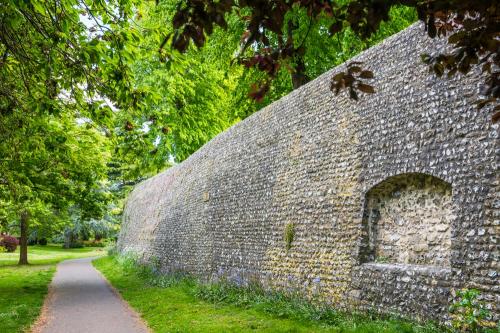
Chichester boasts the best-preserved and least altered Roman city walls in England. The walls date to the 3rd century, when the Romans erected them to defend the city they called Noviomagus Reginorum.
History
Chichester was established as a Roman settlement following the Roman conquest of Britain in AD 43. The city was an important regional centre for the Romanised Celtic tribe known as the Regni, from whom part of its Roman name derived.
The Roman walls of Chichester were constructed around AD 200 as part of the general trend of defensive wall-building across Roman Britain in the late 2nd and early 3rd centuries. They formed a roughly rectangular circuit around the city, about 1.5 miles (2.4 km) in length, enclosing an area of approximately 100 acres (40 hectares).

The walls were built of flint and stone with regular tile courses, originally standing over 23 feet (7 metres) high and 8 feet (2.4 metres) thick, with a walkway along the top.
The walls were augmented by some 60-70 bastions; towers that provided a line of sight along the exposed outer wall. Huge ballistas, a kind of gigantic crossbow, were mounted atop the towers. Today, only four of the original Roman bastions remain. It seems likely that the bastions were not original, but were added in the middle of the 4th century.
The wall incorporated some 5,000 cubic metres of stone and 20,000 cubic metres of infill, mainly chalk and flint, which were plentiful in the area.

The walls survived in good repair for about two centuries, but after the Romans left, they were allowed to decay. Alfred the Great had them rebuilt in the 9th century, but it was left to the Norman invaders in the 11th century to fully restore the walls. They remained in use throughout the English Civil War period.
The wall layout established Chichester's distinctive street pattern that remains visible today, with four main streets (North, South, East, and West Streets) meeting at the medieval Market Cross, following the Roman grid pattern.
There were gates at each of the four compass points. These gates were rebuilt and altered many times over the centuries until they were finally pulled down to ease traffic congestion between 1772 and 1783.

What to See
Today, about 80 per cent of the Roman walls' circuit survives, making them among the most complete Roman defences in Southern England. Visitors can see significant sections of the walls at several locations, including:
1. Priory Park contains one of the best-preserved sections, with the original Roman masonry clearly visible. The best vantage point is outside the park in Jubilee Gardens, where the wall rises to its full height. There are no obvious signs of bastion towers, but it seems likely that tower foundations lie beneath the turf.
2. The Bishops Palace Gardens incorporate sections of the eastern defences. Here you will see the longest and least altered section of the original city walls, along with the remains of several bastion towers.
3. Orchard Street Car Park - a short walk from the Bishop's Palace Gardens, this small car park is home to a section of easily accessible wall. A sharp corner of the wall marks the probable site of a Roman tower.
The walls have been modified and repaired many times over the centuries, particularly during medieval times when they continued to serve as the city's main defences. Many sections show evidence of medieval rebuilding on top of the Roman foundations.
The walls are protected as a Scheduled Ancient Monument and remain one of the most important Roman monuments in southern Britain, providing valuable insights into Roman urban planning and defensive architecture.

Visiting
The Chichester Walls Trust organises regular guided wall walks, but you can walk stretches of the wall at any time by following the City Walls Trail. Plaques set into the ground mark important points along the trail, which is approximately 1.5 miles in length (roughly 2.4km).
The directions given with this article are for the section of wall at Priory Park and Jubilee Gardens.
About Chichester Roman City Walls
Address: Jubilee Park, New Park Road, Chichester,
West Sussex,
England, PO19 1TJ
Attraction Type: Roman Site
Location: You can see the wall in multiple locations around the city centre, including Jubilee Park on New Park Road and in the Bishop's Palace Gardens. For Jubilee Park, use the pay and display car park on New Park Road.
Website: Chichester Roman City Walls
Location
map
OS: SU861047
Photo Credit: David Ross and Britain Express
HERITAGE
 We've 'tagged' this attraction information to help you find related historic attractions and learn more about major time periods mentioned.
We've 'tagged' this attraction information to help you find related historic attractions and learn more about major time periods mentioned.
Historic Time Periods:
Find other attractions tagged with:
2nd century (Time Period) - Alfred the Great (Person) - Roman (Time Period) -
NEARBY HISTORIC ATTRACTIONS
Heritage Rated from 1- 5 (low to exceptional) on historic interest
Pallant House Gallery - 0 miles (Museum) ![]()
Canon Gate - 0.1 miles (Historic Building) ![]()
Chichester Market Cross - 0.1 miles (Historic Building) ![]()
Chichester, St John the Evangelist - 0.1 miles (Historic Church) ![]()
Chichester, St Olave's Church - 0.1 miles (Historic Church) ![]()
Chichester Cathedral - 0.1 miles (Cathedral) ![]()
Chichester Council House - 0.1 miles (Historic Building) ![]()
St Mary's Hospital Almshouses - 0.2 miles (Historic Building) ![]()
Nearest Holiday Cottages to Chichester Roman City Walls:
Runcton, West Sussex
Sleeps: 4
Stay from: £523 - 1517
More self catering near Chichester Roman City Walls



